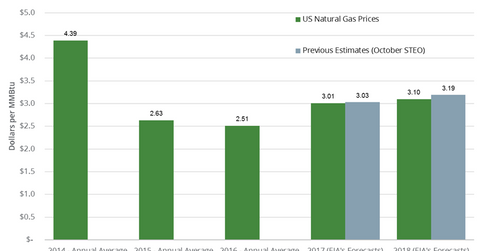What Could Drive US Natural Gas Futures Next Week?
The CFTC reported that hedge funds’ net long positions in US natural gas futures and options contracts rose by 33,734 contracts to 75,297 on November 7–14.
Nov. 24 2017, Updated 10:45 a.m. ET

Hedge funds
On November 27, 2017, the CFTC (U.S. Commodity Futures Trading Commission) will release its weekly “Commitment of Traders” report. In the last report, the CFTC reported that hedge funds’ net long positions in US natural gas (GASL) (UNG) futures and options contracts rose by 33,734 contracts to 75,297 on November 7–14, 2017. The net long positions rose by 57,404 contracts or 320% from the same period in 2016. They’re also near a nine-week high. It suggests that hedge funds are turning less bearish or bullish on US natural gas (DGAZ) (BOIL) prices.
Moving averages
January natural gas (UNG) (FCG) futures were below their 20-day and 50-day moving averages of $3.16 per MMBtu (million British thermal units) and $3.22 per MMBtu on November 22, 2017. They were also below their 100-day moving average of $3.25 per MMBtu. It suggests that prices could trade lower next week. Lower gas prices are bearish for gas producers (PXI) (VDE) like Gulfport Energy (GPOR), EOG Resources (EOG), and Antero Resources (AR).
Natural gas futures drivers
A larger-than-expected fall in natural gas inventories compared to the seasonal and historical average could support natural gas prices. Cold weather forecasts could also support US natural gas (GASL) prices. However, high US natural gas production could pressure gas prices.
EIA’s forecast
US natural gas (UNG) prices could average $3.01 per MMBtu in 2017 and $3.10 per MMBtu in 2018, according to the EIA. US natural gas prices could average $3.1 per MMBtu in 2018, according to World Bank.
Read Could Crude Oil Futures Extend Their Rally? for the latest updates on crude oil.
